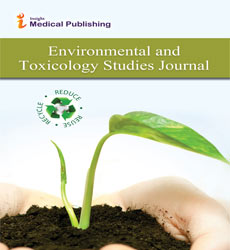Drop Based Microfluidics for Investigating Soil Bacterial Variety
Bocchini Zaia*
Department of Environment, University of Liverpool, UK
Received Date: November 09, 2021; Accepted Date: November 16, 2021; Published Date: November 30, 2021
Citation: Zaia.B (2021) Drop Based Microfluidics for Investigating Soil Bacterial Variety. Environ Toxicol Stud J. Vol.5 No.4:e001.
Abstract
The progress to a total feasible economy requests for a CO2- unbiased energy creation, yet additionally for shut circles in material handling. This challenge can't be met by compound change alone, however needs to incorporate biotechnology process steps, as well. It further advancement relies upon the information and investigation of normal microbial assets, which are a priceless, yet generally non-found regular fortune, up to now. Regular development strategies are restricted in their capacity to make the enormous obscure assortment of normal microbial networks open. Specifically, strategies for high example throughput and huge equal development and testing of bigger boundary spaces are required.Drop based microfluidics permits the parallelization of little development volumes for huge arrangements of microorganisms.
Introduction
The progress to a total feasible economy requests for a CO2- unbiased energy creation, yet additionally for shut circles in material handling. This challenge can't be met by compound change alone, however needs to incorporate biotechnology process steps, as well. It further advancement relies upon the information and investigation of normal microbial assets, which are a priceless, yet generally non-found regular fortune, up to now. Regular development strategies are restricted in their capacity to make the enormous obscure assortment of normal microbial networks open. Specifically, strategies for high example throughput and huge equal development and testing of bigger boundary spaces are required.Drop based microfluidics permits the parallelization of little development volumes for huge arrangements of microorganisms. It is feasible to researching the arrangement of microbial settlements by weakening of obscure networks down to the single-cell level utilizing the standard of "stoachastic control", from one viewpoint, and for investigating the reaction of microbial populaces on natural contaminations, sedates or even exceptional substrates, then again. The supposed "fragmented stream strategy" is specific appropriate for concentrating on the fixation subordinate microbial reaction on convergence of exceptional parts, supplies profoundly settled portion/reaction capacities and guides of combinatorial impacts of poisons.These procedures have been applied for researching soil tests from unique conditions, as mining regions, refining places and archeological locales. In outcome, altogether different soil bacterial networks have been identified and portrayed in their compound reaction conduct, new intriguing species can be found and new bacterial strains of known species with obscure extraordinary physiological properties have been disconnected. Surfactants assume a significant part in bead based microfluidics. The principle motivation behind utilizing a surfactant is to lessen the interfacial pressure between the scattered stage (drop stage, ordinarily fluid) and ceaseless stage (transporter fluid, regularly oil) by adsorbing at interfaces and keeping drops from blending with one another, accordingly settling the drops in a steady emulsion state, which takes into consideration longer stockpiling times in delay-lines, supplies, or vials. Without utilizing surfactants, the shaky emulsions will ultimately develop into isolated stages to decrease the general energy of the system. Surface science can't be overlooked in microfluidics as the interfacial strain turns into a significant thought among microscale droplets. Linas Mazutis and Andrew D. Griffiths introduced a technique that preowned surfactants to accomplish a particular and profoundly controllable blend without outside manipulation. They control the contact time and the interfacial surfactant inclusion of a drop pair to control bead combination. The bigger the distinction level of the interfacial surfactant inclusion between two drops, the more outlandish mixture will happen. This technique permitted scientists to add reagents to drops in an alternate manner and further review the emulsification.The hydrophobic tails on the surfactant keep the emulsion stable and forestall bead mixture together during the hatching time.The bigger/longer the hydrophobic tails are, the better the biocompatibility and the better the solvency in oil stage, additionally the better the insolubility in fluid phase.Microfluidics is broadly utilized for biochemical tests, so it is vital that surfactants are biocompatible while working with living cells and high-throughput analysis. Surfactants utilized in living cell research gadgets ought not disrupt biochemical responses or cell capacities. Hydrocarbon oil is commonly not utilized in cell microfluidic research since it isn't viable with cells and harms cell viability. Hydrocarbon oil additionally separates natural particles from the fluid phase. However, fluorosurfactants with fluorinated tails, for instance, are utilized as a viable bead emulsifier that balances out drops containing cells inside without hurting or changing the cells. Fluorosurfactants are dissolvable in a fluorinated oil (consistent stage) yet insoluble in the watery stage, which brings about diminishing the fluid fluorous interfacial tension.] For instance, a triblock copolymer surfactant containing two perfluoropolyether (PFPE) tails and a polyethylene glycol (PEG) idiot bunch is a fluorosurfactant with extraordinary biocompatibility and great drop security against coalescence.
Open Access Journals
- Aquaculture & Veterinary Science
- Chemistry & Chemical Sciences
- Clinical Sciences
- Engineering
- General Science
- Genetics & Molecular Biology
- Health Care & Nursing
- Immunology & Microbiology
- Materials Science
- Mathematics & Physics
- Medical Sciences
- Neurology & Psychiatry
- Oncology & Cancer Science
- Pharmaceutical Sciences
